Deja Vu – A Plane Spotting Challenge by John Madden
Catch up on the previous reports from this challenge:
Introduction
*Trip Report #1
14th July 2020
Lasham Airfield (A), Bournemouth Airport (B), Southampton Airport (C & F), Lee-on-Solent Airfield (D), Solent Sky Museum (E)

Map of John’s spotting trip.
Anxiety in the air
I must confess that this spotting trip felt most unusual and there was definitely a sense of anxiety in the air as I set off in my Duster at 7am on the morning of the 14th July. To be fair it was good anxiety mixed with a massive dose of excitement at the prospect of visiting four airports/airfileds and one museum all in 12 hours. Past spotting trips usually centred around visiting a single airport or two, calmly settling down at a good viewing location, enjoying the buzz associated with watching and logging aircraft movements and sharing the experience with likeminded spotters. Not this trip, the purpose today was to see and remove as many aircraft types as possible from my list with the highest degree of efficacy possible.
The number of aircraft types to be spotted on this day was pre-defined and largely finite. The chance of any “blue birds” was unlikely, in fact the disappointment of one of the aircraft types having been moved in to a hangar or flown the nest a distinct possibility. The trip should afford such aviation delights as the Boeing 727-200, Boeing 737-200, Britten Norman Trislander, Shorts Sandringham, Jetstream 41 and more. With all my good planning I was still in the hands of the Aviation Gods, hopefully they would look down favourably on me today? Let’s go see.
First airport of the day, somewhere in the undulating Hampshire countryside
Call myself a real Spotter, this was my first ever visit to Lasham airfield! Unforgiveable, I know, but whenever I travel east or west on the M3 there always seems to be an excuse not to go that extra mile to drop in on Lasham. The airfield was once home to Dan Air’s maintenance facility, and although the airline may have faded into aviation history and the airfield’s perimeter a genuine viewing challenge, it is alive and kicking and not without reward. My first flight aboard a Boeing 727-200 was with Dan-Air from Gatwick to Dalaman in 1988, so it felt appropriate to spot this aircraft type at Lasham. To add spice to the return journey that day, the pilot elected to drop into Brussels on an unscheduled refuelling visit. Whilst this didn’t appeal to the other 179 passengers on board, the author revelled in the opportunity to do some chance spotting whilst the cabin crew placated the unhappy campers!
The best vantage point for unhindered views across the airfield is from the Gliding Club visitor’s car park. Unfortunately the facility has not yet re-opened to the general public following the relaxation of many COVID-19 Lockdown restrictions, and I found that the curvature of the airfield prevented any view of the resident classic airliner population from behind the Club’s access gate and airfield security fencing. Knowing that there was a Boeing 737-200 and Boeing 727-200 out there I sped off in search of a crash gate that afforded good views and soon found one on the other side of the airfield just outside Lasham village.
Whilst not perfect, the location does provide views of Boeing 737-200 VP-CAQ and Boeing 727-200 HZ-AB3, both of which were dutifully spotted and removed from my list. There are three additional Boeing 727-200 aircraft on the airfield, but sadly two were completely obstructed behind trees and the other one only just visible amongst a group of parked airliners. However, there was a good mix of Airbus and more modern Boeing types grouped together near the crash gate, one of which was the Jet Airways Boeing 737-900 registered 2-JBZI. Spotting a Boeing 737-900 was unexpected and the type is one of the few remaining modern Boeing 737 variants on my wanted list. In addition to the easyJet Airbus A319s and Ryanair Boeing 737 parked up, of note was the VIP configured TAG Aviation Boeing 757-200 G-TCSX, a recently arrived Jet2 Boeing 737-300, Jet Time Boeing 737-800 OY-JZK and former Norwegian Air Boeing 737-800 EI-FHH in full TUI colours.
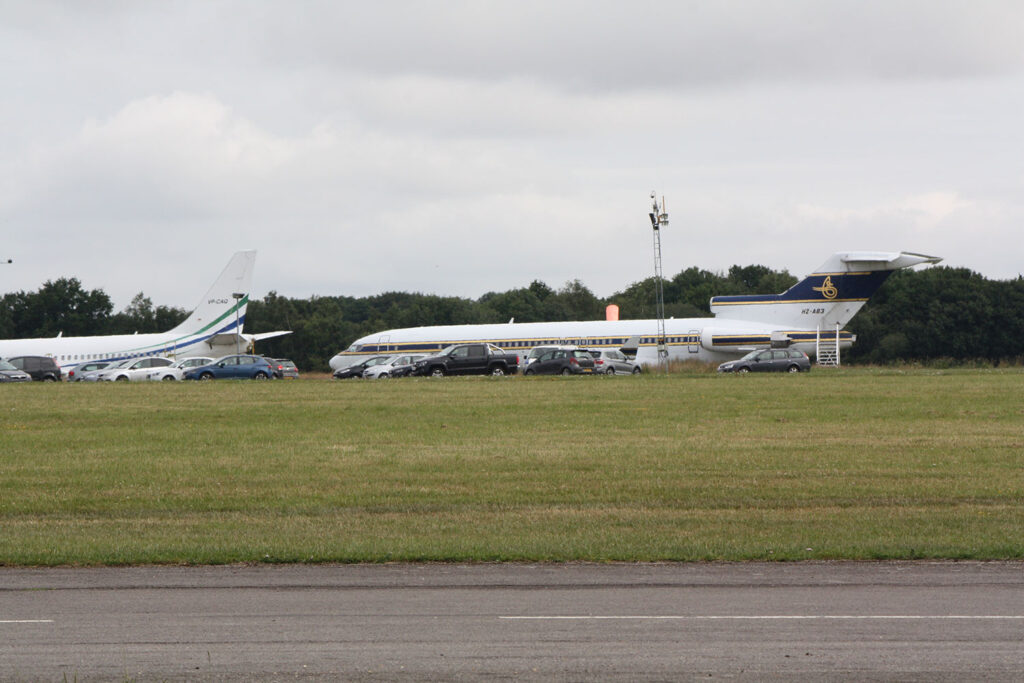
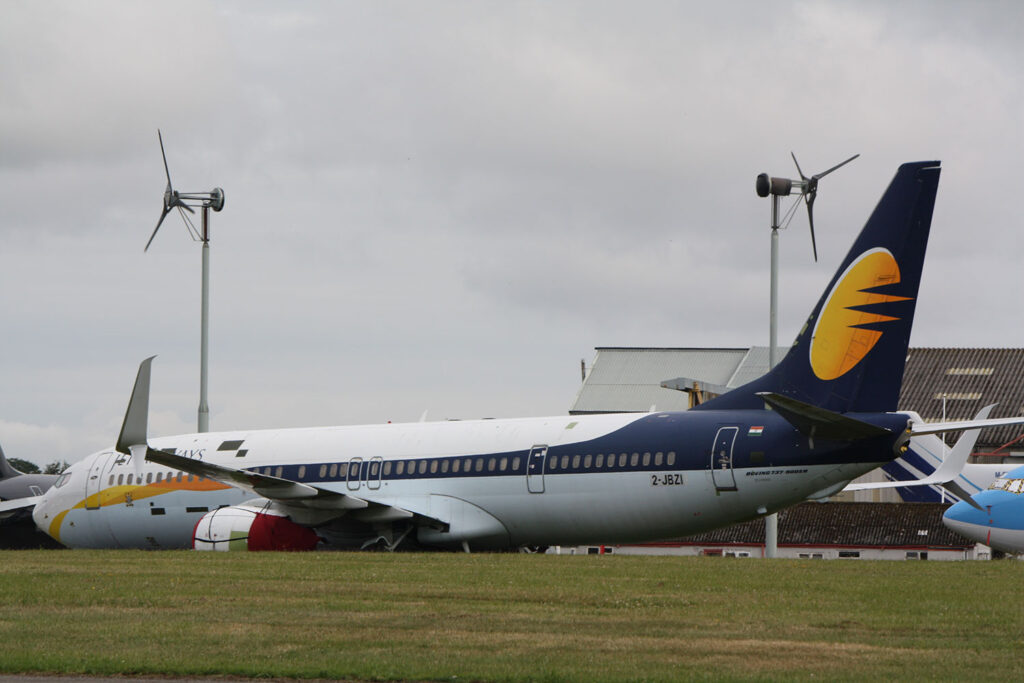
I was aware that both Grand Caravan 208B G-OJMP and Reims-Cessna F406 Caravan II G-BVJT were on the airfield, both of which are aircraft types I needed to spot but couldn’t locate. In addition there were two American light aircraft of note, Beech D17S Speedwing N18028 and Cessna 180E N71CN. Had I been able to access the Glider Club visitor car park I am sure all would have been revealed, including the other three Boeing 727-200s. Despite not one, but the several that got away, the airfield came up trumps and I left in good spirit for my journey to Bournemouth airport. After all, there cannot be many airfields in Europe where one can see such iconic Boeing aircraft as the 727-200 and 737-200 in such good exterior condition parked next to each other, truly fabulous. Three aircraft types deleted from my spotting list during my visit.
Bournemouth Airport
The approach to Bournemouth airport is dominated by the parked up British Airways A319/A320 fleet, much of which you will already have read about. However, the number of aircraft did appear somewhat depleted from the recent photographs I have seen, clearly evidence that some have been recalled to Heathrow for the resumption of European flights. The airport appeared quite sleepy at first glance but the visit did prove to be a most fruitful one for a number of reasons.
First aircraft type on my Bournemouth spotting list was the imposing Conroy CL-44 Skymonster. It is such a pity that there are no surviving CL-44 aircraft including the Canadian Forces’ derivative known as the Yukon, I think you would agree that it was a truly majestic looking aircraft. As the Conroy CL-44 Skymonster uses the lower fuselage, wings, engines and tail of a CL-44, could I dream a little and claim I spotted both aircraft types today? Securing a decent photograph of this fine 1960s aviation conundrum is not that straightforward due the fact that the aircraft is obscured by building materials littered on an enclosed area due for some kind of future development work.
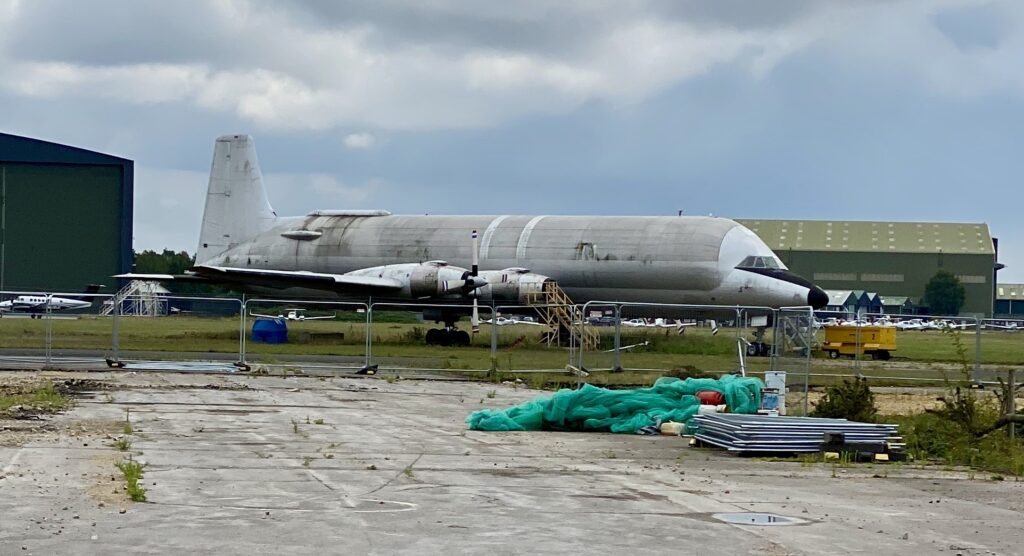
It is many years since I last saw this aircraft and it still looks as impressive today as it did then and thankfully it has managed to dodge the breaker’s torch for the last two decades here on the South Coast of England. With varying rumours abound regarding the future of this magnificent aircraft I do hope fortune looks kindly upon it. After all the concept of an outsized transporter based on an existing aircraft type remains as relevant today as it did in the 1960s. Both the Airbus Beluga XL and Boeing Dreamlifter are supersized versions of mainstream aircraft and are employed in the same way to carry large aircraft parts between manufacturing and final assembly plants. The difference today is scale, and after consulting my calculator I can confidently say that the fuselage, wings, horizontal/ vertical stabalisers and engines could all be swallowed up in one of today’s “Skymonsters”. Now there’s an interesting idea, a most fitting and perfect means of transport to a new permanent home?
Bournemouth airport is also home to the Cobham Special Mission Falcon 20s, another aircraft type on the list and hopefully soon to be Spotted whilst vising the airport. So why the excitement for this biz jet? In its then new role as a converted overnight parcel carrier, this is the bird that literally gave a fledgling FedEx its first wings and shaped the 1970s company into the supply chain legend it is today. The story behind FedEx and how it invented the concept of next day parcel delivery is fascinating, or should I say the method by which the idea for the company came about most certainly is. It was whilst studying at Yale University that Fred Smith the current CEO and founder of FedEx submitted a paper purporting the concept of an overnight hub and spoke based pan-USA parcel delivery service using a fleet of small jets. The University belittled the concept, the idea was discarded and after graduating Fred joined the US Military and served in the Vietnam War for 3 years.
On his return from military service Fred set about raising the capital required to buy 14 Falcon 20s, converted them to freighter configuration and launched FedEx. On the inaugural night in 1973 FedEx carried a mere 136 packages on its fleet of Falcon 20Fs, today FedEx delivers an average of 15 million packages per night and is copied by many other global overnight delivery airlines. FedEx went on to have an eventual fleet of 34 Falcon 20Fs, one of which is preserved at the Smithsonian Museum close to Dulles International airport, a must visit if you have a few hours to spare before an onward flight from Washington. Former FedEx Falcon 20Fs can be still be found in the same role today with airlines such as Kalitta and USA Jet, testament to the design of an aircraft that entered service more than 50 years ago. No less than half a dozen Cobham Falcon 20s were noted during my quick visit to the airport, three of which fortuitously landed only a minutes apart after performing one of their RAF support missions in the English Channel.
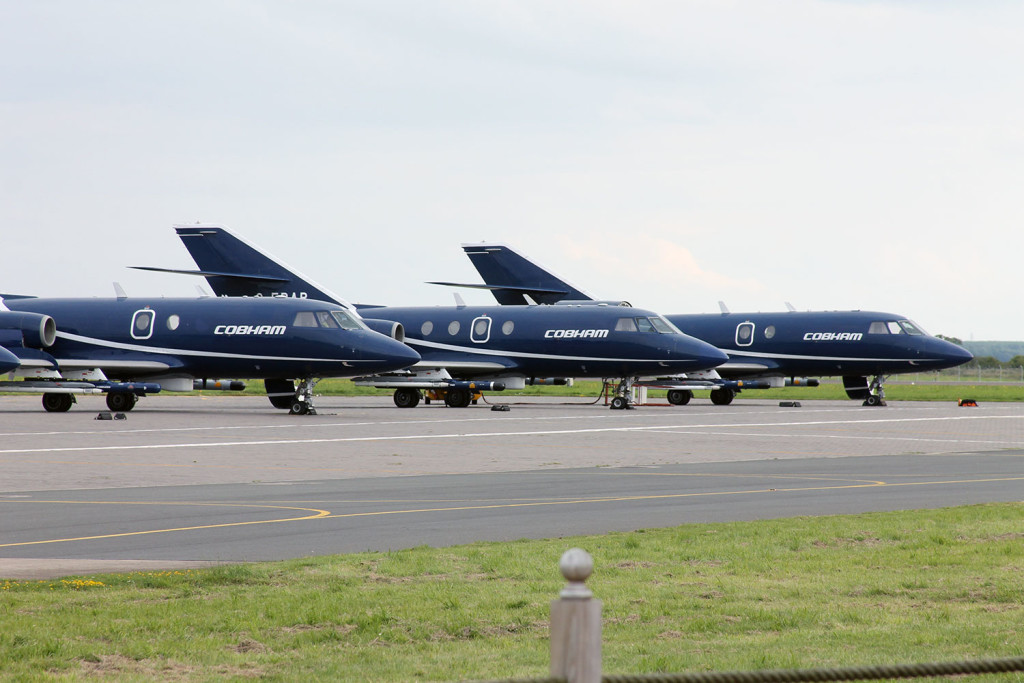
Although I had already spotted 9H-NHS from my virtual airport viewing terrace during Lockdown, you know of my fondness for the A340 family and I was hoping to see the aircraft on the ground during my visit to Bournemouth. Although not there in person due to having been dispatched to China to collect another consignment of PPE, the other Maleth Aero A340-600 siblings were present. Both 9H-EAL and 9H-PPE are used on PPE flights and the former aircraft departed during our visit to Qingdao in support of the every-other-day service from Bournemouth to China in support of such supplies.
The company behind re-purposing the A340-600 as a “freighter” is locally based European Aviation Services (EAS), and in addition to the three “NHS” liveried A340-600 examples already converted on site there was evidence that additional aircraft will soon be added to the Maleth-Aero fleet. Two former Virgin aircraft were clearly being prepared for future freight work with one already sporting the titles “European Cargo – Moving Forward” in large letters along the fuselage and the other example was in the EAS hanger. The company has additional A340-600 aircraft stored away from Bournemouth and anticipates that as many as a total of 10 A340-600 aircraft could be converted to freight configuration (minus large freight door) by the end of 2020. Former Virgin example G-VWIN and now registered 9H-NHS, was previously named “Lady Luck” during airline service. Six months ago no person would have anticipated this new lease of life for the old lady, let us hope that Lady Luck continues to look favourably upon this magnificent aircraft for many years to come.
EAS and other similar aviation maintenance and conversion companies based at the airport provide the spotter with a rich and varied population of airliners, freighters and biz jets. A number of additional aircraft types were removed from my list, including a Gulfstream 3 N623NP (a bit worse for wear but still a beautiful looking aircraft), Gulfstream 550 T7-VOD, Gulfstream 650s M-OVIE and M-USIC, Bae 125-700A M-ALUN, and Cessna 680 Citation SE-RFH. In the maintenance area there was a clutch of Boeings 737 Classics including Swiftair series -300 2-ESKA, Maleth-Aero series 300s 9H-BRE and 9H-PAM, and a very smart looking series -500 ZA-AWA of Albawings. It was also evident from the number of aircraft movements scheduled throughout the day that Ryanair is making a concerted effort to resume a normal service from the airport.
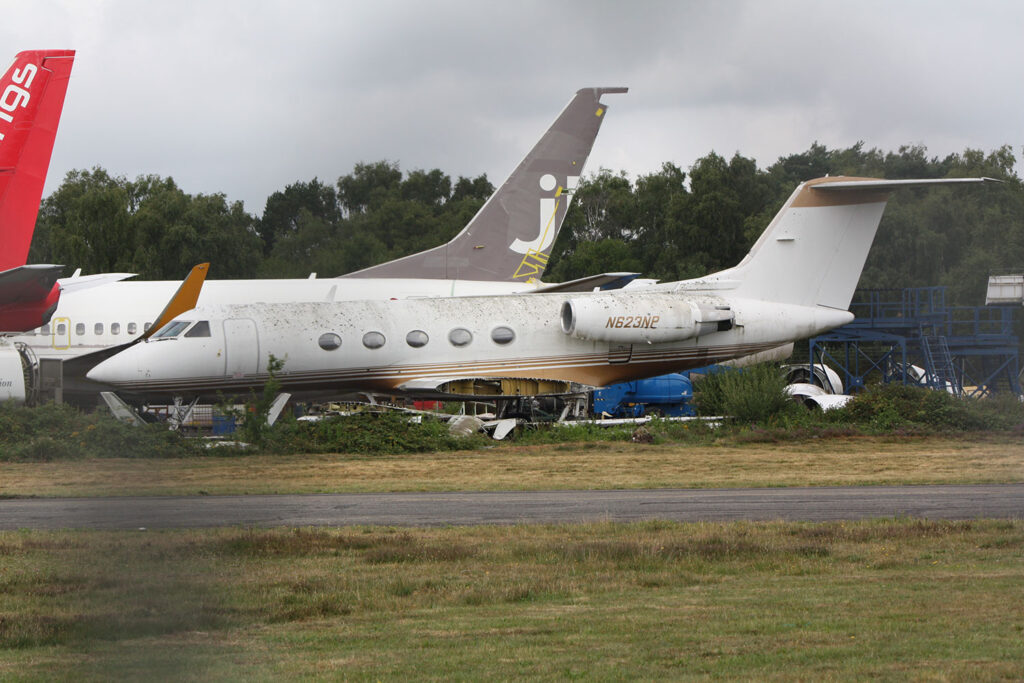
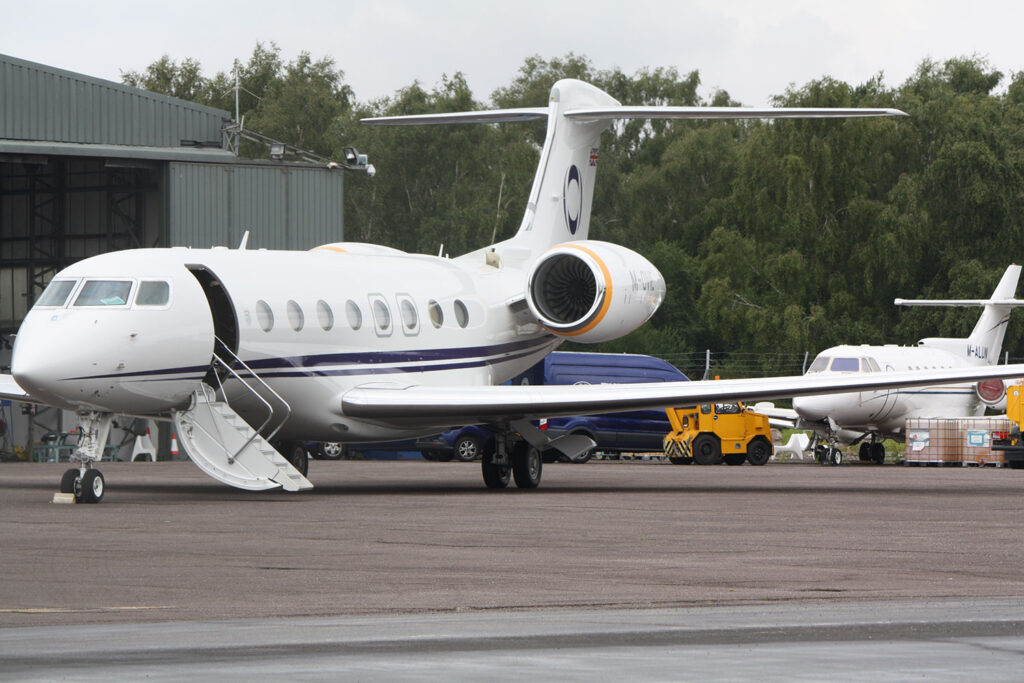
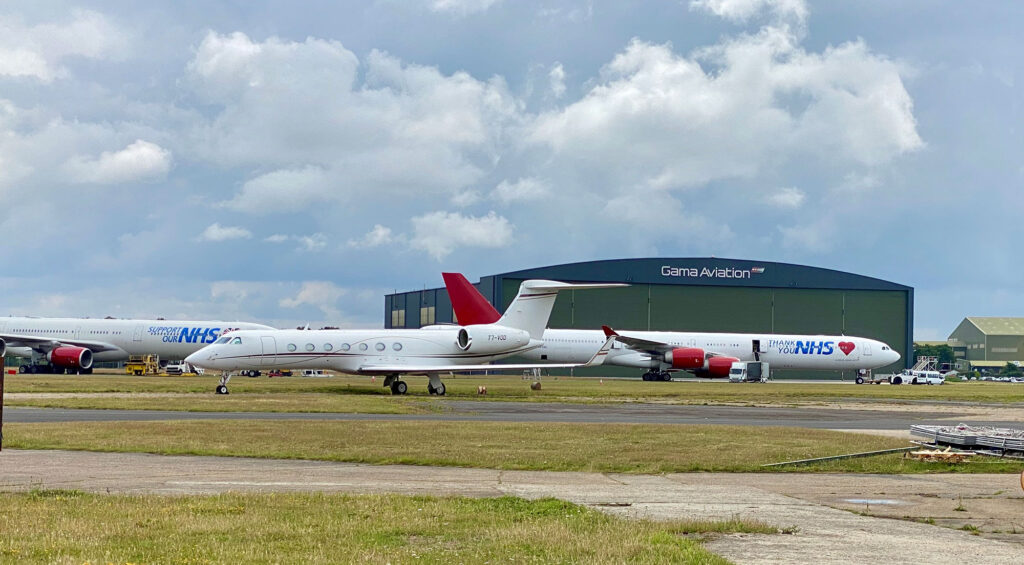
The presence of very active A340-600 and Falcon 20 fleets, numerous Boeing 737 Classics, various biz-jets/props makes this airport an interesting and rewarding spotting destination. Let’s not forget our very old friend the Conroy CL-44 Skymonster either. Seven aircraft types deleted from my Spotting list.
Southampton Airport
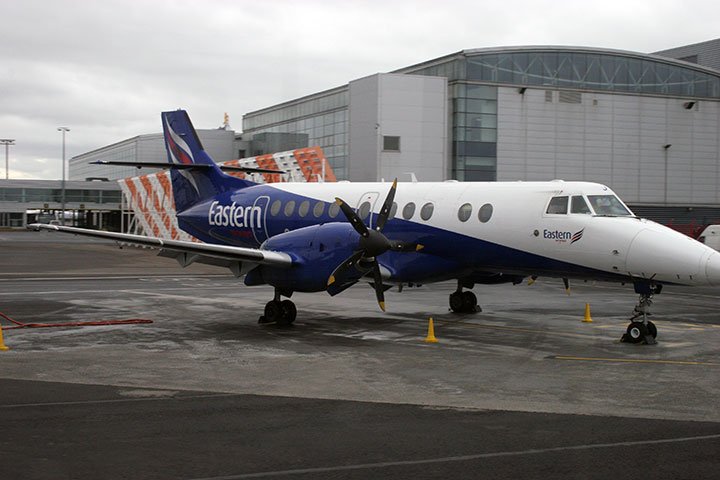
During Lockdown my virtual viewing terrace had been bereft of propeller driven regional airliners, so this visit to Southampton airport was most timely and despite a much reduced timetable expected to deliver a few welcome aircraft types such as the Jetstream 41 and ATR 72 and possibly a Bombardier Q400 from the now defunct Flybe. My virtual viewing balcony in Ascot was good and certainly served its purpose during Lockdown, but not as good as the real thing, an airport. The former carrier had been the largest airline at the airport and the current flight schedule, even taking Lockdown into consideration, clearly reflects this.
Back in 2011 I had the pleasure of taking a flight aboard an Eastern Airways Jetstream 41 from Southampton to Teesside via Leeds Bradford and was delighted to see that the airline had not only resumed some services post-lockdown but was also deploying the aircraft on some of the former Flybe routes out of Southampton.
I had long wished to fly the Jetstream 41 again and an opportunity presented itself last December when the Telecoms company I work for in Cardiff invited me to attend their Xmas dinner party. For non-Spotters the obvious travel itinerary’ would be to book an afternoon train to Cardiff and take the last train home after dinner. I was aware of the Jetstream 41 PSO flight between Cardiff and RAF Anglesey and enquired about timings and costs. The flight from RAF Anglesey was less than £20 so I went ahead and booked a seat along with a train ticket from Ascot to Anglesey via Euston, Crewe and Chester, all coordinated to arrive in time to catch the afternoon flight to Cardiff and most importantly within the travel budget. Not only would I have the opportunity to fly on an old favourite aircraft type again, but I would do it from an airport I had never flown from before.
The journey went very well until I reached Crewe where I discovered that there were “horses” on the line to the north of the station and all onward services were severely delayed. I missed the onward connection to Anglesey, missed the flight to Cardiff and ended up taking a cross country train back south to the Welsh capital. I did manage to make both the meal and the last train home but spent several days licking my wounds and trying to re-establish my pride. Just for the record, I would attempt the same extravagance again and most certainly will do so when the next opportunity arises. Isn’t that what Aircraft Spotting is all about?
Unintentionally, spotting both the ATR 72 and Jetstream 41 today ended up requiring two visits to the airport! With a much reduced flight schedule I had planned to catch both aircraft types around lunch time before my visit to the other remaining two locations on the tour. My visit to the airport was intended to a swift clinical affair but unfortunately I arrived too late and missed the 11:55 Eastern Airways Jetstream flight to Belfast. I did however manage to catch the Aurigny ATR 72-600 during her 30 minute turn around along with a forlorn looking FlyBe Bombardier Q400 G-ECOM. Having reviewed Flightradar24 a decision was made to recover the situation by returning to airport later that afternoon to Spot the Jetstream 41 scheduled for the 17:00 departure to Darlington via Leeds. Perhaps this return visit was meant to happen as in addition to Spotting the departing Jetstream 41, I was gifted with a departing Bombardier CL-605 EI-WFI, Falcon 900 VP-BPW and the spuriously registered Lear Jet 45 M-RBIG. Both these two aircraft were on my wanted list so the return visit was well worthwhile as I had been unable to see them earlier in the day. Other biz jets/props on the ground included a Cessna CJ4 ZJ-THC and several Manx registered PC-12 aircraft.
I do wish this important Regional airport all the very best for the future and that an airline or airlines step in and ramp up the number of destinations and departures to the levels enjoyed during the summer or 2019. This time last year FlyBe flew to more French destinations from the UK than any other airline, and all from a single airport.
Solent Sky Museum – Southampton
My quest to spot every aircraft type would not be possible without visiting aviation museums, and Solent Sky Museum is the first of what will prove to be many enjoyable visits to such establishments. Thanks to the many aviation enthusiasts and groups out there we are still afforded the chance to see many aircraft types that would otherwise have met their fate in a lonely scrapyard. There may be many museum collections and often they are located in some of the most bizarre places across the planet, but each portrays the individual aviation spirit and engineering flair exhibited by that nation state at particular moment in history. The Solent Sky Museum does a magnificent job at capturing the national aviation spirit and in particular that associated with the open water.
The main reason for my visit to the Solent Sky Museum was to spot the Shorts Sandringham, an aircraft type originating from de-commissioned Shorts Sunderland aircraft and one which has very strong ties to the local area. RAF Calshot on Southampton water was once a seaplane station and frequented both during and post Second World War by the Sunderland family of aircraft. The Shorts Sandringham on display is in fact the last such aircraft to serve in a Commercial role and was retired in 1974 after flying her last passenger flight with Ansett Airlines. The aircraft is maintained in top condition and I very much recommend that you take advantage of the opportunity to look around the interior. I sat down in one of the passenger seats (I was amazed to count 43 very spacious seats), closed my eyes and imagined just for a moment what it must have been like to be surrounded by the deafening roar of 4 Pratt & Witney piston engines as the aircraft mounted the “Step” just before launching itself off the water?
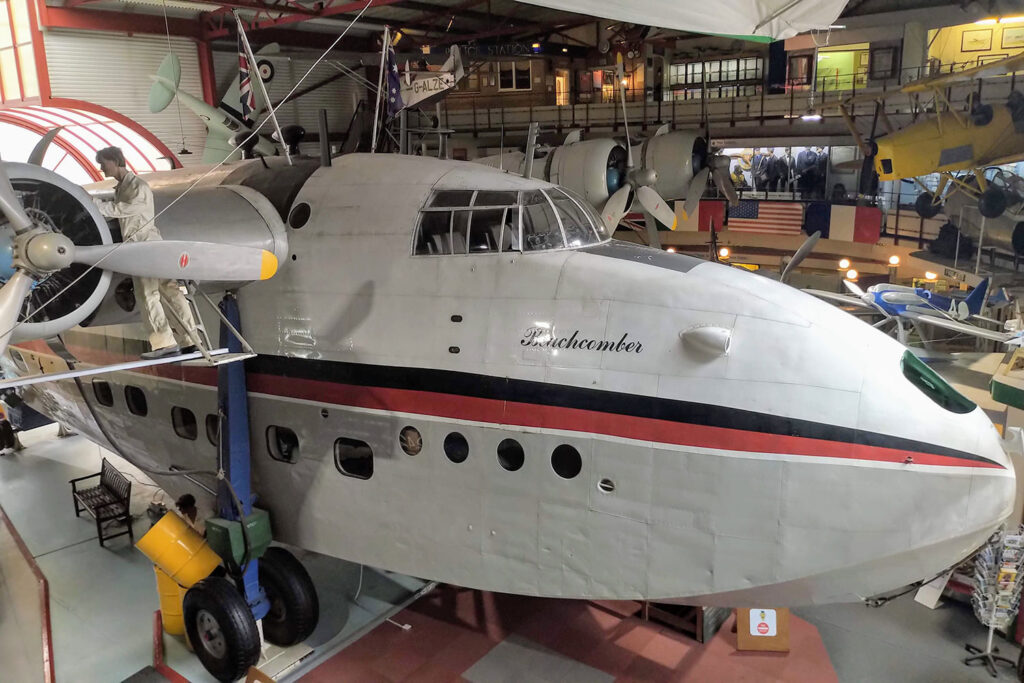
My affection for this aircraft type stems from a most fortuitous meeting with a Shorts Sunderland back in the summer of 1982. On the first morning of a two day Spotting visit to Heathrow and Gatwick I met a professional photographer on the Queens Building who happened to mention that a Shorts Sunderland was due to land hat day on the Thames just downstream from Tower Bridge. Unexpected news but I’m very interested, please carry on I said. The real rub in this chance meeting was that the photographer had heard a rumour that the pilot was considering a flypast “through” the open bridge before landing. Off we hurried to central London and took up our position near the Tower of London to witness what could turn out to be the highlight of any Aviation Spotter’s career. Sadly, or perhaps for the better, the Sunderland landed downstream and was towed to a mooring position between HMS Belfast and Tower Bridge.
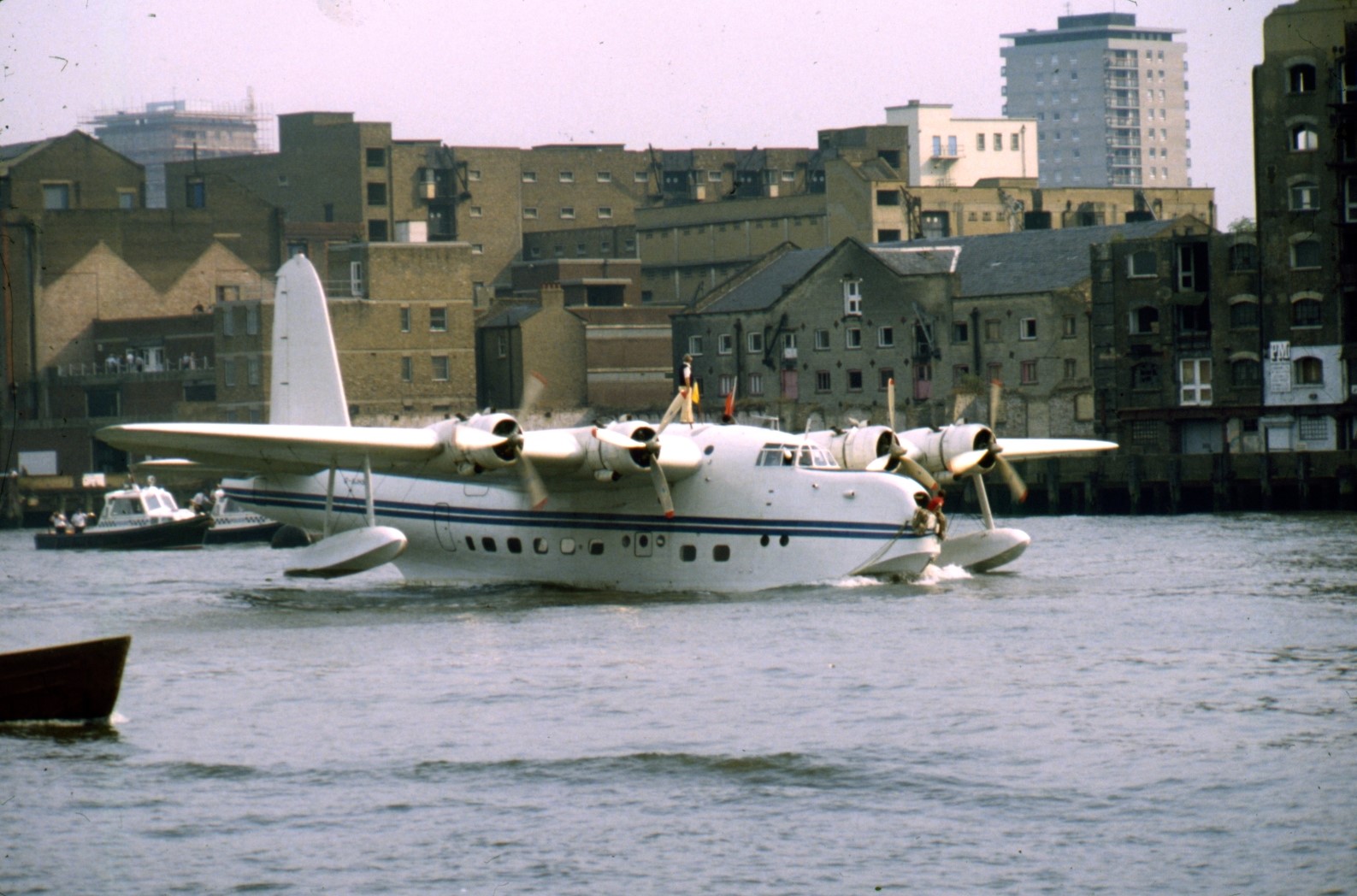
For the record, albeit with narrow margins, the Sunderland could have flown through the open bridge with sufficient space either side of the wing tips and plenty of spare head room between the top of the tail fin and the underside of the bridge’s gantry. She soon left and not surprisingly ended up in the former RAF station at Calshot where it spent several years being prepared to fly to its current home as part of the Kermit Weeks collection in Florida. I am sure many of you visited her during her stay in Calshot and witnessed her final departure from Southampton. In my first posting regarding this Spotting challenge I did promise that I would include a photograph taken of me proudly standing in front of the Sunderland during her stay on the Thames, well here it is. Two worrying conclusions from this early 1980s photograph, hideous fashion and a lack of any railings to prevent one from tumbling in to the Thames.
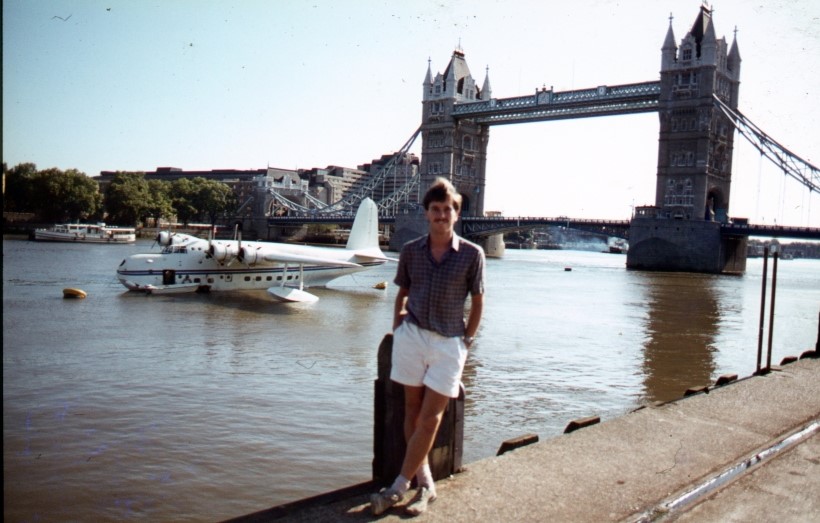
Today’s long Spotting Day also included a trip to Lee-on-Solent airfield to spot retired Aurigny B-N Trislander G-RLON owned by the Sky Solent Museum but currently located at the airfield whilst space for display is made available at the Museum in Southampton. Aurigny flew Trislanders in to Southampton airport from the Channel Islands for over 4 decades so the choice to exhibit this locally manufactured aircraft type in Southampton is most fitting. I never had the pleasure of flying on a Trislander, but the aircraft was always a joy to spot whenever I was visiting the South Coast or Scotland. I’m also intrigued by an unresolved mystery surrounding this aircraft type. Back in the 1980s eleven Trislander kits were supplied to a Florida based company named International Aircraft Corporation for assembly and sale in the US market. The venture did not succeed and one of the eleven kit was returned to the UK and later assembled for onward sale to Aurigny, but the whereabouts of the remaining 10 kits remains a mystery. I do hope one day to see an episode of the US TV series American Pickers when the presenters of the show stumble across a remote barn packed full of Trislander kits in perfect condition and ripe for assembly! Joking apart, we can but live in hope.
As the weather had closed in for the worse as I arrived at Lee-on-Solent, I decided to park up at Café Zero-5 located next to the airfield Tower and indulge myself in a coffee until the torrential rain stopped. This is a splendid establishment, great food and beverages and with a garden eating area with uninterrupted views over the airfield and not surprisingly runway 05. The proprietor Lisa is such a nice person and so engaging, as is Colin one of the local aviation enthusiasts who pointed me in the direction of the only viewing spot to clearly see the Trislander. If you are lucky you may bump into the occasional notable personality at ZERO 5; Lisa told me about when Tim Peake dropped in. The café suits Spotters and non-Spotters alike, I will most definitely return to the establishment when the resident Spitfire commences flying again.
The Solent Sky Museum really is an aviation gem, every nook and cranny filled with fantastic exhibits. The Covid-19 “Track and Trace” document that I signed when entering the Museum clearly indicated that we need more aviation enthusiasts to visit our Museums. I never once felt exposed during my visit and the establishment clearly takes the virus very seriously with visitor health their number one priority right now. I also had the pleasure of meeting with Steve Alcock the Museum Manager, a true fountain of Aviation knowledge. Learning of my Spotting challenge we discussed the topic for a while and thanks to Steve I dutifully left the Museum with an additional few aircraft types to be added to my Spotting list. Please do go out of your way to visit this Museum, you will not be disappointed.
Conclusion
Spotting trip number ONE completed. It really was a tiring day but only because of the demanding schedule I set myself and a few unexpected mishaps along the way, one of which I have shared with you. In total I spotted 18 aircraft types to eliminate from my list and met Lisa, Colin and Steve along the way. There will be days when I certainly spot more required aircraft types than today, and I am sure some days less. For the record a BN Defender flew over the car when I was driving from Bournemouth Airport on what turned out to be the first of two visits to Southampton airport, but I was unable to determine its exact identity so another aircraft type evaded me for now.
Number of types spotted so far: 62
I do hope that you enjoyed today’s spotting tour as much as I did and that you will take the time to join me on my next excursion.
Leave a comment below!






7 comments
Well Done John good report and interesting personal challenge for you.
Seeing the CL44 reminded me of photographing a Heavylift example at East Midlands back in August 1983.(EI-BND)
Of course digital wasn’t even conceived then, but managed to get a respectable shot or 2 not thinking at the time how rare, then obsolete it would become. So seeing you photo was a nostalgic reminder of the more challenging and in some ways more rewarding times in planespotting.
To think now I can sit in my office, check on FR24 inbound to LHR perhaps tomorrow morning, see something I eagerly want, drive down 5 hours (overnight) turn up wait for it to arrive, photo and log it spend the rest of day there capturing others and go home.
Not often are there big surprises with the same excitement we had back then. (to use a 21 century phrase The WOW! factor)
And we used to meet up and talk about the “do you remember when? or Was you here when…? And if you owned a radio… you really was the biz!
Looking forward to your next installment!
Regards
Julian
Hi Julian.
Thanks for your kind words, much appreciated. I have fond memories of EI-BND in Heavylift colours too, didn’t think back then that she was such a rare commodity. Added another aircraft type to my list today, an Avanti raced over my back garden en route to Northolt at just 5,000 ft, what a sound and spectacle, she was in a hurry dodging the LHR arrivals and departures. Just planning my next Spotting Trip, hope you enjoy it.
John
Thank you, John, for your excellent report on a very busy day.
I don’t get to the south coast often but, as my son lives in Dorchester, I spend some time there house- and cat-sitting there while they are on holiday. I’ve been to Bournemouth Airport a few times (to deposit or retrieve them) but have never seen the CL-44; I must try harder next time. The museum there is definitely worth a trip.
I’ve often intended to go a bit further to Solent Sky but, for one reason or another, I have never quite managed it. Thanks to your report, I’ve resolved that I absolutely *must* make it happen next time. I do worry about the economics of Aviation museums in the present unparalleled times; we must all do our bit to support them.
Thanks again, keep up the good work.
[…] up on the previous reports from this challenge: Introduction Trip Report #1 Trip Report #2 Trip Report #3 *Trip Report […]
John – Thanks for an interesting series of articles – brought back memories of LHR Queen’s building visits in the 50/60/70’s for me – loys of Connie’s I remember well, such an iconic design.
Any spotting location tips for Bournemouth or Southampton as these are my locals now?
Thanks
Robert
[…] up on the previous reports from this challenge: Introduction Trip Report #1 Trip Report #2 Trip Report #3 Trip Report #4 Trip Report #5 *Trip Report […]
An interesting read, { I visited Solent Sky last year & thought the place was brilliant, well kept with many interesting aircraft types displayed, I’ll be interested to see where they squeeze in the Trislander.. Talking of Trislanders ( & to make you envious John) I’ve made 74 flights in Trislanders – living in Guernsey they were at the time the only aircraft available for inter island journeys & the aircraft of choice (cheap) for spotters charters.